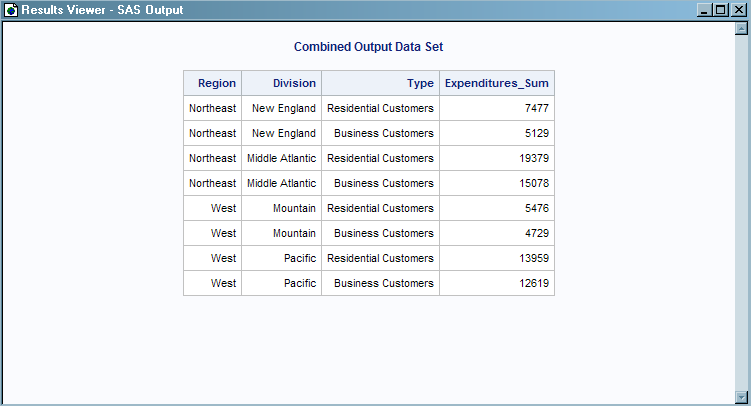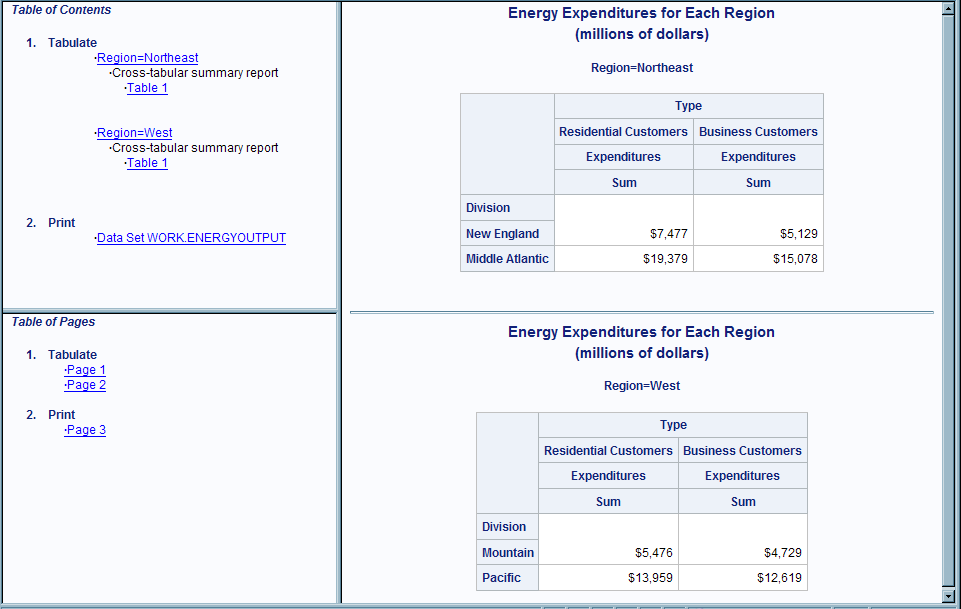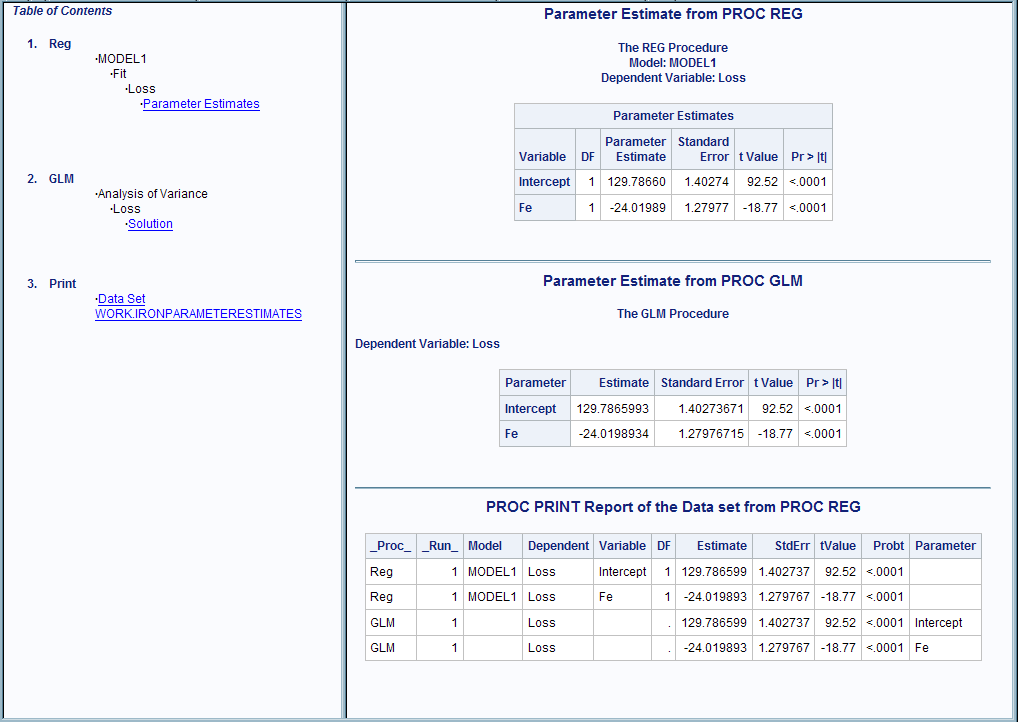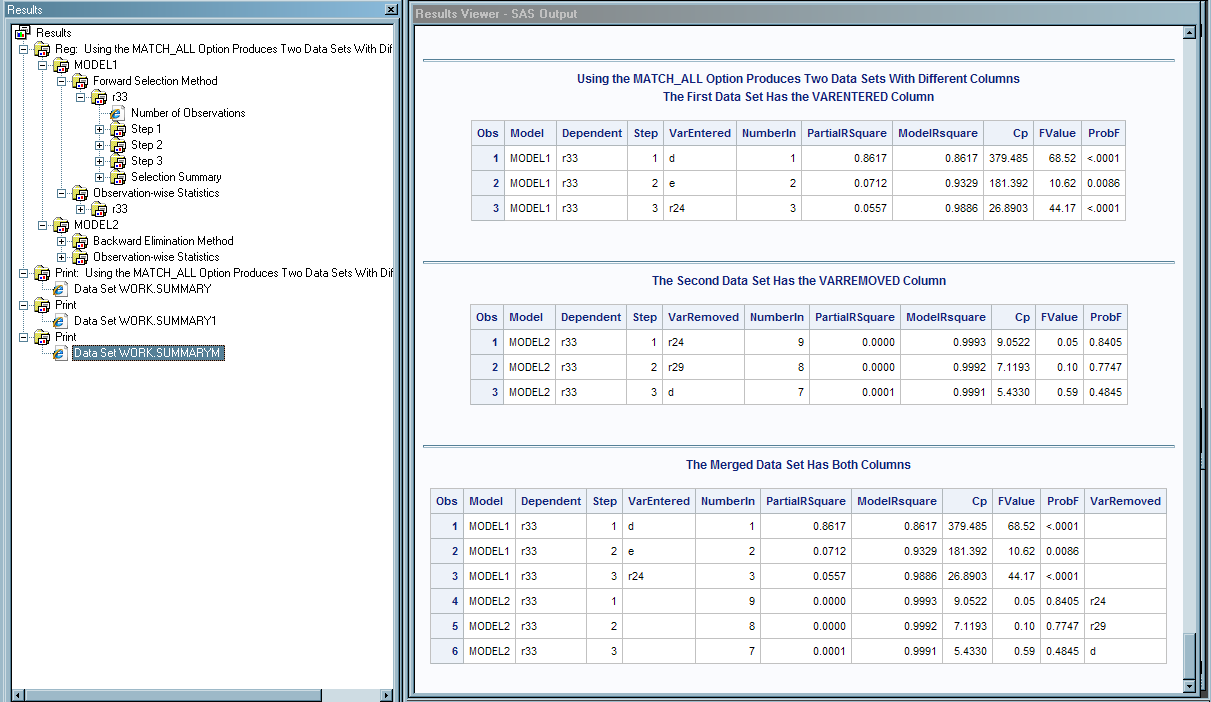ODS OUTPUT Statement
Produces a SAS data set from an output object and
manages the selection and exclusion lists for the OUTPUT destination.
| Valid in: | Anywhere |
| Category: | ODS: SAS Formatted |
Syntax
ODS OUTPUT action;
ODS OUTPUT data-set-definition(s);
Actions
The following actions are available for the ODS OUTPUT statement:
Required Arguments
- data-set-definition
-
provides instructions for turning an output object into a SAS data set. ODS maintains a list of these definitions. This list is the selection list for the OUTPUT destination. For information about how ODS manages this list, see Selection and Exclusion Lists. Each data-set-definition has the following form:output-object-specification<=data-set>
- output-object-specification
-
has the following form:output-object<(MATCH_ALL<=macro-var-name> PERSIST=PROC | RUN)>
- output-object
-
identifies one or more output objects to turn into a SAS data set.To specify an output object, you need to know which output objects your SAS program produces. The ODS TRACE statement writes to the SAS log a trace record that includes the path, the label, and other information about each output object that is produced. For more information, see the ODS TRACE statement. Output Objects can be specified as the following:
-
a partial path. A partial path consists of any part of the full path that begins immediately after a period (.) and continues to the end of the full path. For example, suppose the full path is the following:
Univariate.City_Pop_90.TestsForLocation
Then the partial paths are as follows:City_Pop_90.TestsForLocation Tests For Location
-
a partial label path. A partial label path consists of any part of the label that begins immediately after a period (.) and continues to the end of the label. For example, suppose the label path is the following:
"The UNIVARIATE Procedure"."CityPop_90"."Tests For Location"
Then the partial label paths are as follows:>"CityPop_90"."Tests For Location" "Tests For Location"</
Tip:To create multiple data sets from the same output object, list the output object as many times as you want. Each time you list the output object, specify a different data set.
- MATCH_ALL=<macro-var-name>
-
creates a new data set for each output object. For an explanation of how ODS names these data sets, see the discussion of the option data-set.
- macro-var-name
-
specifies the macro variable where a list of all the data sets that are created are stored. If you want to concatenate all the data sets after the PROC step, you can use the macro variable to specify all the data sets in a DATA step.
Tip:The MATCH_ALL option is not needed to merge conflicting output objects into one data set.CAUTION:A data set that is produced by SAS 9.1 without MATCH_ALL might not be identical to a data set that is produced by SAS 9.0 with MATCH_ALL and then concatenated in a DATA step. With SAS 9.0, merging dissimilar output objects with the MATCH_ALL option could result in missing columns or truncated variables. With SAS 9.1, these restrictions do not apply.For more information about merging output objects, see Merging Dissimilar Output Objects into One Data Set.
- PERSIST=PROC | RUN
-
determines when ODS closes any data sets that it is creating, and determines when ODS removes output objects from the selection list for the OUTPUT destination.
- data-set
-
names the SAS output data set. You can use a one-level or two-level (with a libref) name.If you are creating a single data set, then the ODS OUTPUT statement simply uses the name that you specify. If you are creating multiple data sets with MATCH_ALL, then the ODS OUTPUT statement appends numbers to the name. For example, if you specify
testas data-set and you create three data sets, then ODS names the first data settest. The additional data sets are namedtest1andtest2.Note: If you end the filename with a number, then ODS begins incrementing the name of the file with that number. For example, if you specifymay5as data-set and you create three data sets, then ODS names the first data setmay5. The additional data sets are namedmay6andmay7.Default:If you do not specify a data set, then ODS names the output data set DATAn, where n is the smallest integer that makes the name unique.Tip:You can specify data set options in parentheses immediately after data-set.
Details
Merging Dissimilar Output Objects into One Data Set
By default, the ODS
OUTPUT statement puts all output objects that have the same output-path into one SAS data set, regardless
of any conflicting variables in the output objects. Variables created
by a later output object will get a value of missing in the observations
created by the earlier output object. Variables created by an earlier
output object that do not exist in a subsequent output object will
get a value of missing in the observations added by the later output
object. If a variable created by an output object has a different
type than a variable with the same name created by an earlier output
object, it will be added to the output data set using a new name formed
by adding a numeric suffix.
Examples
Example 1: Creating a Combined Output Data Set
| Features: |
ODS _ALL_ CLOSE statement
ODS LISTING statement:: CLOSE ODS OUTPUT statement |
| Other features: |
PROC FORMAT PROC PRINT PROC TABULATE KEEP= data set option |
| Data set: | Energy |
Details
This example routes
two output objects that PROC TABULATE produces to both the OUTPUT
destination and the HTML destination. The result is two output objects
that are combined by the ODS OUTPUT statement to create an output
data set formatted as HTML output by the ODS HTML statement.
Note: This example uses
filenames that might not be valid in all operating environments. To
successfully run the example in your operating environment, you might
need to change the file specifications. See ODS HTML Statements for Running Examples in Different Operating Environments.
Program
proc format;
value regfmt 1='Northeast'
2='South'
3='Midwest'
4='West';
value divfmt 1='New England'
2='Middle Atlantic'
3='Mountain'
4='Pacific';
value usetype 1='Residential Customers'
2='Business Customers';
run;
ods output Table=energyoutput(keep=region division type expenditures_sum);
ods html body='your_body_file.html' frame='your_frame_file.html' contents='your_contents_file.html' page='your_page_file.html';
proc tabulate data=energy format=dollar12.;
by region;
class division type;
var expenditures;
table division,
type*expenditures;
format region regfmt. division divfmt. type usetype.; title 'Energy Expenditures for Each Region'; title2 '(millions of dollars)'; run;
ods html path='../ods'(url=none)
body='odsoutput-printbody.htm';
ods html body='your_body_file_2.html';
proc print data=energyoutput noobs; title 'Combined Output Data Set'; run;
ods _all_ close; ods HTML;
Program Description
Format the variables Region, Division, and Type.PROC FORMAT creates formats for Region, Division,
and Type.
proc format;
value regfmt 1='Northeast'
2='South'
3='Midwest'
4='West';
value divfmt 1='New England'
2='Middle Atlantic'
3='Mountain'
4='Pacific';
value usetype 1='Residential Customers'
2='Business Customers';
run;Create the SAS output data set and specify the variables
that you want to be written to the output SAS data set.The ODS OUTPUT statement creates the SAS data set
EnergyOutput from the output objects that PROC TABULATE produces.
The name of each output object is Table. You can determine the name
of the output objects by using the ODS TRACE ON statement. The KEEP=
data set option limits the variables in the output data set EnergyOutput
to Region, Division, and Expenditures_sum. The variable name Expenditures_sum
is generated by PROC TABULATE to indicate that the sum statistic was
generated for the Expenditures variable.For more information,
see ODS TRACE Statement.
Create HTML output.The ODS
HTML statement creates the body, frame, contents, and pages files.
The output from PROC TABULATE is sent to the body file. FRAME=, CONTENTS=,
and PAGE= create a frame that includes a table of contents and a table
of pages that link to the contents of the body file. The body file
also appears in the frame.
ods html body='your_body_file.html' frame='your_frame_file.html' contents='your_contents_file.html' page='your_page_file.html';
Create output data sets and an HTML report.This PROC TABULATE step creates two output objects
named Table, one for each BY group, and adds them to the EnergyOutput
data set. Because the HTML destination is open, ODS writes the output
to the body file.
proc tabulate data=energy format=dollar12.;
by region;
class division type;
var expenditures;
table division,
type*expenditures;format region regfmt. division divfmt. type usetype.; title 'Energy Expenditures for Each Region'; title2 '(millions of dollars)'; run;
Close the current body file and open a new file. Create
HTML output.The ODS HTML BODY= statement
closes the original body file and opens a new one. The contents, page,
and frame files remain open. The contents and page files will contain
links to both body files. The ODS HTML statement opens the HTML destination
and creates HTML output. The output from PROC TABULATE is sent to
the body file. FRAME=, CONTENTS=, and PAGE= create a frame that includes
a table of contents and a table of pages that link to the contents
of the body file. The body file also appears in the frame.
Print the combined data set. This PROC PRINT step prints the data set EnergyOutput that contains
both BY groups. The output is added to the current body file, your_body_file_2.html.
Example 2: Using Different Procedures to Create a Data Set from Similar Output Objects
| Features: |
ODS OUTPUT statement ODS SELECT statement |
| Other features: |
PROC GLM PROC PRINT PROC REG |
| Data set: | Iron |
Details
This example creates
and prints a data set that is created from the parameter estimates
that PROC REG and PROC GLM generate. These procedures are part of
SAS/STAT software.
Note: This example uses filenames
that might not be valid in all operating environments. To successfully
run the example in your operating environment, you might need to change
the file specifications. See ODS HTML Statements for Running Examples in Different Operating Environments.
Program
options nodate pageno=1 pagesize=60 linesize=72;
ods html body='parameter-estimates-body.htm'
frame='parameter-estimates-frame.htm'
contents='parameter-estimates-contents.htm';
ods select ParameterEstimates(persist);
ods output ParameterEstimates(persist=proc)=IronParameterEstimates;
proc reg data=iron; model loss=fe; title 'Parameter Estimate from PROC REG'; run; quit; proc glm data=iron; model loss=fe; title 'Parameter Estimate from PROC GLM'; run; quit;
ods select all;
proc print data=IronParameterEstimates noobs; title 'PROC PRINT Report of the Data set from PROC REG'; run;
ods _all_ close; ods html;
Program Description
Set the SAS system options for the LISTING output.The NODATE option suppresses the display of the date
and time in the LISTING output. The PAGENO= option specifies the starting
page number. The PAGESIZE= option specifies the number of lines on
an output page. The LINESIZE= option specifies the output line length.
Create HTML output.The ODS
HTML statement creates the body, frame, and contents files. The FRAME=
and CONTENTS= options create a frame that includes a table of contents
that links to the contents of the body file. The body file also appears
in the frame.
ods html body='parameter-estimates-body.htm'
frame='parameter-estimates-frame.htm'
contents='parameter-estimates-contents.htm';Specify the output objects to be sent to all open ODS
destinations.The ODS SELECT statement
specifies that output objects named ParameterEstimates should be sent
to all open ODS destinations that do not specifically exclude them.
The LISTING destination is open by default, and its default list is
SELECT ALL. The ODS HTML statement has opened the HTML destination,
and its default list is also SELECT ALL. Thus any object that is named
ParameterEstimates will go to both these destinations. The PERSIST
option specifies that ParameterEstimates should remain in the overall
selection list until the list is explicitly modified.
Create the IronParameterEstimates data set.The ODS OUTPUT statement opens the OUTPUT destination
and creates the SAS data set IronParameterEstimates. By default, the
list for the OUTPUT destination is EXCLUDE ALL. This ODS OUTPUT statement
puts ParameterEstimates in the selection list for the destination.
The PERSIST=PROC option specifies that ParameterEstimates should remain
in the overall selection list until the procedure ends or the list
is explicitly modified.
Create the output objects.PROC REG and PROC GLM each produce an output object named ParameterEstimates.
Because the data set definition persists when the procedure ends,
ODS creates an output object from each one.
proc reg data=iron; model loss=fe; title 'Parameter Estimate from PROC REG'; run; quit; proc glm data=iron; model loss=fe; title 'Parameter Estimate from PROC GLM'; run; quit;
Enable all open destinations to receive output objects.The ODS SELECT ALL statement sets the lists for all
destinations to their defaults so that ODS sends all output objects
to the HTML and LISTING destinations. (Without this statement, none
of the output objects from the following PROC PRINT steps would be
sent to the open destinations.)
Print the reports.The PROC
PRINT steps print the data set that ODS created from PROC REG and
PROC GLM. The output from these steps goes to both the HTML and the
LISTING destinations. Links to the HTML output are added to the contents
file.
proc print data=IronParameterEstimates noobs; title 'PROC PRINT Report of the Data set from PROC REG'; run;
HTML Output
The HTML output includes
the parameter estimates from PROC REG, the parameter estimates from
PROC GLM, and a report of the data set that ODS created from each
set of parameter estimates.
The table of contents
identifies output objects by their labels. The label for ParameterEstimates
in PROC REG is Parameter Estimates. The corresponding label in PROC
GLM is Solution. Notice how the column widths in the HTML output are
automatically adjusted to fit the data. Compare this layout to the
layout of the columns in the LISTING output.
Example 3: Creating a Data Set with and without the MATCH_ALL Option
| Features: |
ODS HTML statement options:: BODY= ODS LISTING ODS OUTPUT statement:: MATCH_ALL ODS TRACE statement |
| Other features: |
PROC PRINT PROC REG |
| Data set: | Model |
Details
This example illustrates
the differences in the data sets created by specifying the MATCH_ALL
option and by not specifying the MATCH_ALL option. The first program
creates a merged data set by specifying the MATCH_ALL option. The
second program creates a merged data set without specifying the MATCH_ALL
option.
The data sets that are
printed are parameter estimates that PROC REG generates. The PROC
REG procedure is part of SAS/STAT software.
Note: This example uses filenames
that might not be valid in all operating environments. To successfully
run the example in your operating environment, you might need to change
the file specifications. See ODS HTML Statements for Running Examples in Different Operating Environments.
Program 1
ods output SelectionSummary(match_all=list) = summary; title1 'Using the MATCH_ALL Option Produces Two Data Sets With Different Columns';
ods trace on;
proc reg data=model;
model r33=a b r4 r8 c d e r23 r24 r29/ selection=forward
sle=.5 maxstep=3;
model r33=a b r4 r8 c d e r23 r24 r29/ selection=backward
sls=0.05 maxstep=3;
run;
ods trace off;
title2 'The First Data Set Has the VARENTERED Column'; proc print data=summary; run; title1; title2 'The Second Data Set Has the VARREMOVED Column'; proc print data=summary1; run;
data summarym; set &list; run;
title1; title2 'The Merged Data Set Has Both Columns'; proc print data=summarym; run;
Program Description
Prepare a SAS data set to be created.The ODS OUTPUT statement opens the OUTPUT destination.
By default, the list for the OUTPUT destination is EXCLUDE ALL. This
ODS OUTPUT statement puts SelectionSummary in the selection list for
the destination. The MATCH_ALL option produces a SAS data set for
each instance of SelectionSummary. The name of the first data set
is Summary, and the name of the second data set is Summary1. ODS stores
a list of these names in the macro variable list. This variable is
used later in the example to combine the data sets.
ods output SelectionSummary(match_all=list) = summary; title1 'Using the MATCH_ALL Option Produces Two Data Sets With Different Columns';
Create the output objects and view a record of them in
the log.PROC REG creates the output
objects. The ODS TRACE statement writes to the SAS log a record of
each output object that is created. The ODS TRACE OFF statement represses
the printing of the records.
ods trace on;
proc reg data=model;
model r33=a b r4 r8 c d e r23 r24 r29/ selection=forward
sle=.5 maxstep=3;
model r33=a b r4 r8 c d e r23 r24 r29/ selection=backward
sls=0.05 maxstep=3;
run;
ods trace off;Print the reports.The PROC
PRINT steps print the data sets that ODS created from PROC REG. The
output from these steps is sent to the HTML destination.
title2 'The First Data Set Has the VARENTERED Column'; proc print data=summary; run; title1; title2 'The Second Data Set Has the VARREMOVED Column'; proc print data=summary1; run;
Create a data set that contains all of the data sets.The data set SummaryM combines all the data sets
that were created by the ODS OUTPUT statement. The
macro variable &list contains
the list of data set names.
HTML Output
The first data set
created when using the MATCH_ALL option: This HTML output contains
a printed report of the Summary data set created by the ODS OUTPUT
statement with the MATCH_ALL option specified. It has no VARREMOVED
column.
The second data set
created when using the MATCH_ALL option: This HTML output contains
a printed report of the Summary1 data set created by the ODS OUTPUT
statement with the MATCH_ALL option specified. It has no VARENTERED
column.
The merged data set
created when using the MATCH_ALL option: This HTML output contains
a printed report of the SummaryM data set created by the ODS OUTPUT
statement with the MATCH_ALL option specified. This is the data set
created from Summary and Summary1. It contains both the VARENTERED
and VARREMOVED columns.
Program 2
ods output SelectionSummary=summary;
title1 'Without the MATCH_ALL Option, ODS Produces a Single Data Set With All
Of the Columns';
ods trace on;
proc reg data=model;
model r33=a b r4 r8 c d e r23 r24 r29/ selection=forward
sle=.5 maxstep=3;
model r33=a b r4 r8 c d e r23 r24 r29/ selection=backward
sls=0.05 maxstep=3;
run;
ods trace off;
proc print data=summary; run;
Program Description
Prepare a SAS data set to be created.The ODS OUTPUT statement opens the OUTPUT destination
and creates the SAS data set Summary. Because the MATCH_ALL option
is not specified, ODS creates one data set that contains all instances
of the output object SelectionSummary.
ods output SelectionSummary=summary;
title1 'Without the MATCH_ALL Option, ODS Produces a Single Data Set With All
Of the Columns';Create the output objects and view a record of them in
the log.PROC REG creates the output
objects. The ODS TRACE statement writes to the SAS log a record of
each output object that is created. The ODS TRACE OFF statement represses
the printing of the records.
ods trace on;
proc reg data=model;
model r33=a b r4 r8 c d e r23 r24 r29/ selection=forward
sle=.5 maxstep=3;
model r33=a b r4 r8 c d e r23 r24 r29/ selection=backward
sls=0.05 maxstep=3;
run;
ods trace off;



